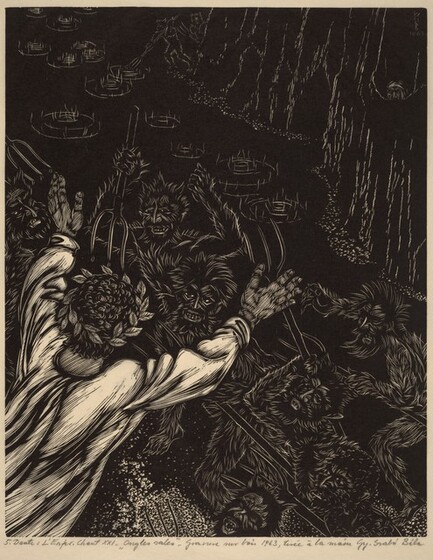Romanian artist Gy Szabo Bela (1905-1985) portrayed with “hand printed wood engraving on Japanese paper” a depiction of Dante’s Inferno, called Dante: L’enfer, Chant XXI, Ongles sales (Dante’s Inferno, Canto XXI, Nasty Claws, 1963). — “Dante: L’enfer, Chant XXI, Ongles sales (Dante’s Inferno, Canto XXI, Nasty Claws), 1963,” National Gallery of Art
Bob Dylan, “A Hard Rain’s A-Gonna Fall” (1963)

“I saw a black branch with blood that kept drippin’…” A reference to Pier delle Vigne, Inf. 13?
Contributed by Lorenzo Hess (Bowdoin, ’23)
Miracle Strip Amusement Park
 “Miracle Strip Amusement Park opened in 1963 with the Starliner Roller Coaster as it’s main attraction. Located across from the beach in Panama City, the park did not look like your average theme park and resembled the traditional seaside boardwalks of the past. The park featured many of the typical rides you would find at any carnival nowadays including scramblers, bumper cars, a carousel and a haunted house. Some of the rides, such as the Abominable Snowman and Dante’s Inferno, were enhanced by placing them in dome structures and adding lighting effects, temperature changes, smoke effects and music.
“Miracle Strip Amusement Park opened in 1963 with the Starliner Roller Coaster as it’s main attraction. Located across from the beach in Panama City, the park did not look like your average theme park and resembled the traditional seaside boardwalks of the past. The park featured many of the typical rides you would find at any carnival nowadays including scramblers, bumper cars, a carousel and a haunted house. Some of the rides, such as the Abominable Snowman and Dante’s Inferno, were enhanced by placing them in dome structures and adding lighting effects, temperature changes, smoke effects and music.
In 2003, it was announced that the park would close the following year due to lack of interest, loss of money and increased expenses to keep the rides maintained and running. Many of the rides were either sold off or disappeared, some being found and reopened under the same name. Any of the remaining structures or rides that weren’t sold were later demolished.”
Read more at AbandonedFL.com
Paul Taylor, “Scudorama” (1963, 2009)
 “In Scudorama eight dancers, wearing street clothes and bright leotards and using beach towels as shrouds (with sets and costumes designed by the artist Alex Katz), disintegrate into ravaged forms. Like shifting shadows they crawl across the floor in jagged bursts of bewilderment, emptiness and rage. The dance’s accompanying program note, from Dante, begins with ‘What souls are these who run through this black haze?’ For Mr. Taylor, those words refer to the ‘lost souls in purgatory, because they hadn’t done anything good and they hadn’t done anything bad.'” [. . .] –Gia Kourlas, The New York Times, February 13, 2009
“In Scudorama eight dancers, wearing street clothes and bright leotards and using beach towels as shrouds (with sets and costumes designed by the artist Alex Katz), disintegrate into ravaged forms. Like shifting shadows they crawl across the floor in jagged bursts of bewilderment, emptiness and rage. The dance’s accompanying program note, from Dante, begins with ‘What souls are these who run through this black haze?’ For Mr. Taylor, those words refer to the ‘lost souls in purgatory, because they hadn’t done anything good and they hadn’t done anything bad.'” [. . .] –Gia Kourlas, The New York Times, February 13, 2009

